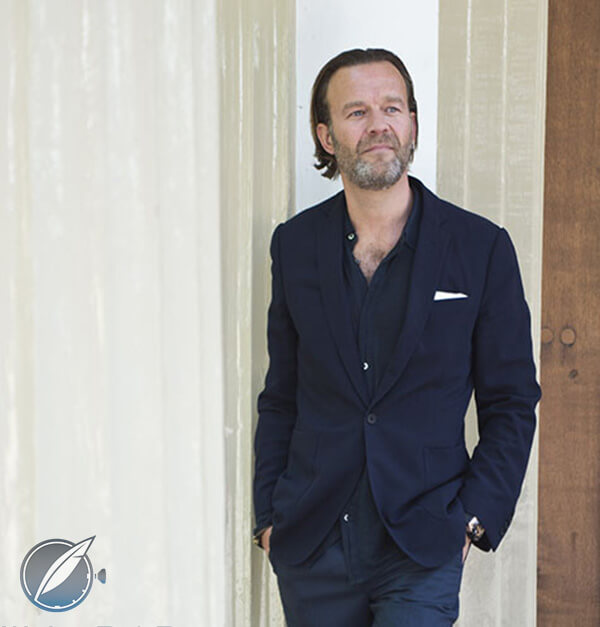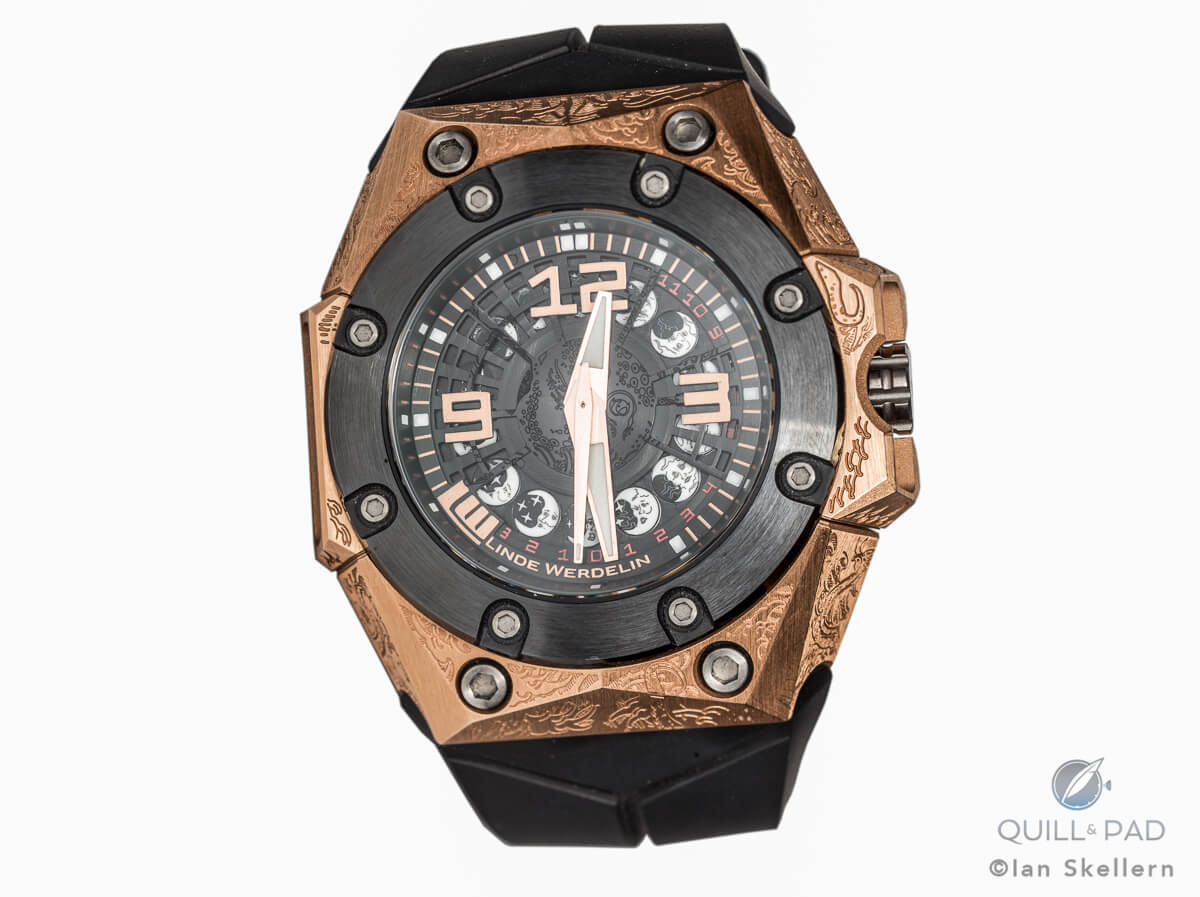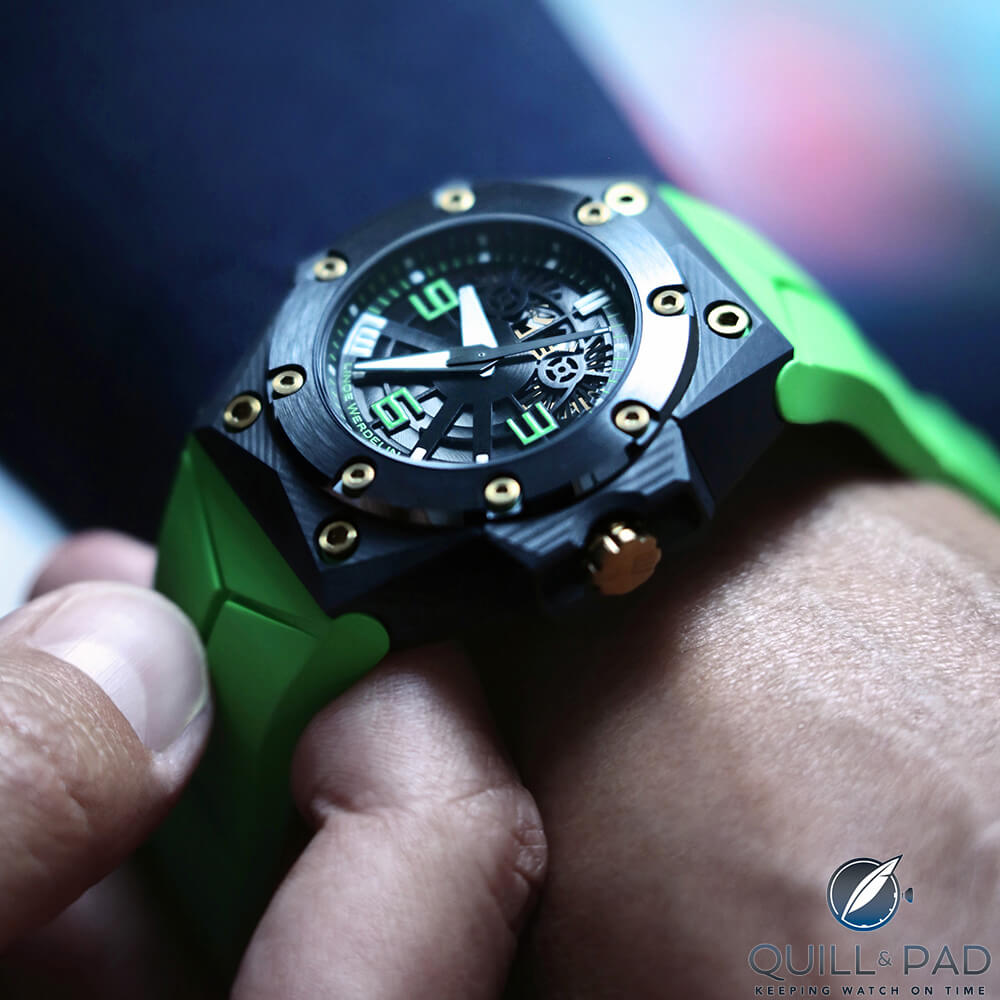by Martin Green
In a world where marketing often gets the upper hand, an honest insight into the inner workings of the watch industry is a rare treat. Especially when provided by the co-founder of a brand and published in a world-renowned publication like The Financial Times (FT).

Jorn Werdelin, co-founder of Linde Werdelin
This is exactly what happened when Jorn Werdelin, co-founder of Linde Werdelin, was interviewed by the FT recently. In honest and straightforward words, he painted a picture of how he perceives the current state of the watch industry, and it’s a rather grim image with too many brands making too many watches for too few customers. The following highlighted quotes from the FT interview put the focus Werdelin’s concerns.
“In some ways, I think much of the industry has lost sight of the fact that we are making luxury goods, and that means things which should be desirable and at least relatively rare. But when I see the big groups pushing so hard to increase production, to make ever more models and to open mono-brand stores which squeeze traditional retailers, I start to become a little bit afraid.”
This honesty was not appreciated by every corner of the watch industry as Werdelin veered off the yellow brick road, revealing that the great and powerful Oz isn’t so great after all.
“Scarcity must remain the key — lose that, and I think the attraction [of a luxury watch] is gone.”
An independent watch brand often comes with an independent mind, and independent minds are hard to keep quiet. In my personal opinion, whether we like it or not I feel that Werdelin provided factual representation of the current state of the market.
“There has been an enormous amount of creativity during the past 10 or 15 years, but I can really see all that disappearing. If we face difficult times ahead, I expect the big groups will get bigger — and that makes me wonder whether or not we will see the beginning of the end of smaller, independent brands, which are often the really creative ones.”
However, I also had the impression that Werdelin’s Financial Times interview begged for a followup, so here it is!
Q&P: Recently you did an interview with The Financial Times, in which you talked about the current situation in the watch market. Some responses from the industry were not positive toward your airing of this. How do you feel about that?
JW: I feel good about it because I think it’s important to have a view. When doing the interview, I had customers in mind and I believe it’s only reasonable to share some transparency with them. I am a fairly upfront person and am thoughtful as to what’s going on in the watch market at the moment. We live in a digital age where the immediacy of information means it is impossible to fool the customers; they are smart, savvy, and well-informed. The fact that the industry is in trouble is not news.
Q&P: In the article you gave a more in-depth look into the watch industry and the way it functions, providing perhaps more information than is generally known to the public. Part of the watch industry leans on myths and marketing; what do you think is the effect of providing information that might take some of that magic away?
JW: Great myths or great stories will never really diminish in value. Their significance and influence will always overshadow any small truths exposed over time. Marketing plays its role in communicating stories to the public, but it should not be used to outright lie to or deceive the customer. Truth and authenticity are required.
Q&P: Do you notice that consumers are changing?
JW: Oh, yes. The consumer is getting younger, more knowledgeable, and is less concerned about actual ownership of luxury goods. Life moves at a faster pace and consumers are more centered on experiences. They have ease of access – for example, with vintage goods consumers can swap or sell their belongings as and when their interests change. With the accumulation of production, nothing is rare anymore. So I think this is a positive development. Mass consumerism is lowering and there is no longer the need to produce so much anymore.
Q&P: In the watch industry you have in general the large conglomerates and the smaller, independent players. How do you think both types of player will (need to) develop to cope with the new market conditions?
JW: Large conglomerates will cope because they are more powerful and have more control of the distribution channels. I think it will become increasingly hard for independent watchmakers to become “brands,” by which I mean established and respected. Traditional retail and wholesale have been squeezed, which has meant they are cutting independent brands and taking products to the grey market. For independents to survive, we should stay closer to the customer.
Q&P: Market conditions at this level are hard to influence as a whole, let alone as a niche player like Linde Werdelin, yet you still need to survive in this market. What is Linde Werdelin’s strategy to make this happen?
JW: Our aim is to innovate and instate new methods of communication with our customers. With the launch of LW Vintage, we looked to diverge from the traditional sales channels and incorporate our own based on current market trends. As with our Try It service and LW by Appointment, the end goal is to bridge the gap between ourselves and our customers.

Linde Werdelin Oktopus Moon Tattoo
So Werdelin does not think that market conditions are very good in the watch world; is that a bad thing? Conditions like this tend to spark ingenuity, new approaches, and further development of the product and the services around it. A great example is LW Vintage, which Werdelin already mentioned in the interview.
Here, Linde Werdelin facilitates the sale of a pre-owned Linde Werdelin timepiece by acting as the bridge between seller and buyer. Linde Werdelin verifies each watch sold and offers the new owner a 24-month guarantee as well as a new strap.

Oktopus Double Date Green by Linde Werdelin
This might well be a side business different from the actual development and manufacturing of watches, but at the same time it can represent a vital service toward becoming actively involved in the pre-owned market of one’s own brand.
I am convinced that for many watch collectors and connoisseurs Werdelin was only stating the obvious.

Oktopus Carbon Moon by Linde Werdelin
However, those who criticized the initial interview in The Financial Times may only need a bit more time before they are ready for reality to set in. We can only hope that they don’t take too long, because as history has showed us many times before, waiting too long might end up in running out of time altogether.
You can read the full Financial Times interview by clicking Jorn Werdelin on a Glut of Luxury Watches and for more information on the brand, please visit www.lindewerdelin.com.
Leave a Reply
Want to join the discussion?Feel free to contribute!

I applaud Mr. Werdelin for his honesty. Although this should not be surprising to anyone who is into watches. The writing was on the wall for the past two years. Watch pricing does not seem realistic and sustainable. The watch industry should be getting more young people into horology by offering more entry level product. In addition to this they have to compete with smart watches for the younger demographic.I like what Mr. Biver is doing at Tag Heur offering the connected watch with the option to trade up into a mechanical watch. All he seems to get is criticism, but there needs to be more programs like this. The market needs to be broadened with more people being brought into the tent. While the APs, Pateks, Vacherons, double tourbillons etc. are great, only a small percentage of people can afford them and a smaller percentage of those people will buy them. It’s almost like most people in the watch industry are happy to service a small number of rich old people. This is the definition of a declining market. I fear by the time a proper response is formulated, it will be too late.
True words Richard! TAG Heuer, but also De Grisogono and Frederique Constant, are trying to get their head around the changing markets. Biver is getting a lot of criticism, but I believe that he thrives on it, because to him its probably a good indication that he is on the right track.
I think that the real problem is that a lot of brands have lost touch with their loyal consumer base, but went solely for increased profits. Now the well is drying up, many brands are dying to get the original customers back in their reach, but for many the prices have indeed elevated to a level they cannot, or want not, afford them anymore.
Agreed Martin, I should have also included De Grisogono and Frederique Constant, I love what Frederique Constant did with their perpetual watch, I think that watch will be a game changer.
As an industry observer, I find it very interesting to see the responses of all the different brands. Frédérique Constant is for sure a brand with an excellent strategy, and I must say flexibility. The big question for me right now is what are the Japanese brands up to?
Brands? Is there more than one?
yes agreed. watches are no longer only loved by aged men. the young generation of today loves them too but the problem is you need a ton of money to buy “exclusivity”. the shift in the industry may happen, may not happen.
the other thing, in times of recession and crisis, the luxury market is hit the hardest; luxury isn’t necessary to survive and as the world progresses towards a dystopia (quite probable because of current economic situation), things will look bad for the luxury market
I see both problems and opportunities, at least from the collectors’ view. The “scarcity” is often based on a “pseudo-scarcity” to raise prices artificially. Some watch companies have released limited editions of some etching on the back of the case, plunked in a junked up movement, and pronounced it as a “limited editions” (One of the more notorious instances is the Panerai 318 c. OPXXIX, “Brooklyn Bridge.”) The scarcity is based on a marketing decision and not on the time and care it takes to build a better movement, design and watch.
For the collector, and by extension the market, smaller companies that lovingly produce watches based on expertise and excellence—with very small production numbers and reasonable prices—has become a viable alternative. (Habring2, the Austrian watchmaker that has won three (3) Grand Prix d’Horlogerie de Genève awards, produces about 150 watches per year, and their Felix introduced their first in-house movement—and won the Petite Aiguille GPHG prize—sells for under $5,000. By the way, Habring2 has won three more awards than Rolex.)
The alternative is largely based on the Internet in terms of knowledge, purchase and access—and discussion groups; not “expert publications” that must rely on companies like Panerai for advertising revenue are believed over experienced watch journalists. Yes, the number of pseudo-experts and general loudmouths on the Internet is legion, and there’s probably more misinformation than good information. However, the “honesty” heralded in Mr. Werdelin’s interview implies that such honesty is rare coming from the mouths of watch manufacturers. In the current state of the world with access to big data sources, multi-threaded search engines, and intimate details of just about everything; knowledge is no longer the exclusive domain of the expert any more than it is the domain of the medieval European priests who could read and write Latin.
Maybe the watch companies will take a page from some 12-year old who knows his way around the Internet and really listen for a change. You can only sell the Brooklyn Bridge so many times before the out-of-towners are wise to the scam.
True words spoken, Bill! Information is there in abundance, but the quality of it varies indeed. I therefore think that it’s also the obligation of every watch enthusiast to share his/her knowledge with people who are just getting their feet wet. This way they can get a good start into the watch world.
Regarding the word “honesty” – this does not reflect on others, saying that they might be dishonest, but more to the sense that marketing has come to rule the industry. My mailbox fills up every day with press releases, many of which read like a fairy tale. I understand that watch companies are in it to make a profit, but I do think that they should apply constraint in times of abundance, otherwise they might find themselves crossing a bridge too far….(pun intended).
Mr. Werdelin’s interview (and the great follow up) are signaling the right path for the whole watch industry.
Strange to see the “old boys” in their “club” thinking that what used to work will continue to do so forever, and trying to protect their old world by attacking honest (and different) views like Mr. Werdeline’s.
I agree with Richard Baptist about the new approach required.
The industry’s response to the smart watch was so far more of a “knee jerk” and not a serious comprehensive thought and effort to incorporate technology and introduce generation Y millennials to watches.
Haute Horology should remain scarce and could remain expensive, while new entry level approaches should be wider spread and affordable.
The smart watch industry did not introduce a “game changer” app YET, and so far fails epically in producing a prestigious status symbol, but are we all going to sit and wait for it to happen?
Thanks for sharing your thoughts, Yanir. Like you, I also believe that even in the smartwatch world haute horlogerie will continue to exist. I do expect that the quartz-powered watch is in grave danger. Especially when smartwatch technology will become less expensive (and it will) and the batteries better, the added value of a quartz movement will deteriorate quite fast. Entry- and mid-level mechanical watches will probably also still be able to capture the heart of the enthusiast, but like you point out, we do need to get new generations involved and interested in watches. All I can say that its going to be quite an interesting time for the watch industry as a whole!
The attack on Werdelin reminds me of the attack on Compass Box Whisky, who are kind of stating the same thing. That being truthful and transparent about your industry should endear you to your customer. Deceiving the customer is very last century.
Well said, Rman!
LW has lost millions and millions of Danish kroner with their business. Incredible that they continue.
You should actually make a story about this: Why 2 guys chooses to continue a business that have cost them millions of € the last 10 years. In Morten Lindes case it has cost him almost all the money he got from his father – I expect his own holding company to have a negative equity end of this year. And this is a guy that always has been living large – very large, and now must seriously drop his living standards.